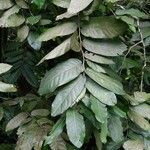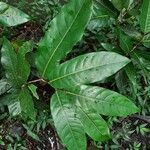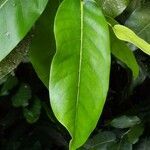Tree to 30 m high; trunk irregularly fluted and buttressed. Leaves: lamina oblong, 9–35 cm long, cordate at base, entire margin, acuminate to emarginate at apex, glabrous, glossy, coriaceous; petiole 4–10 mm long. Spikes 1–10 cm long, subsessile, simple or branched from base. Flowers scented. Calyx c. 5 mm long, broadly bilobed, whitish. Petals linear, subequal, c. 12 mm long, crumpled, white to pale yellow; tubular base c. 6 mm long. Stamens alternating, c. 3 mm and c. 5 mm long, enclosed by corolla tube. Fruit broadly ovoid to ellipsoidal, 5–9 cm long, oblique, somewhat compressed, obliquely beaked, narrowly keeled on one side, indehiscent, woody, fibrous, glabrous, yellow when mature.




